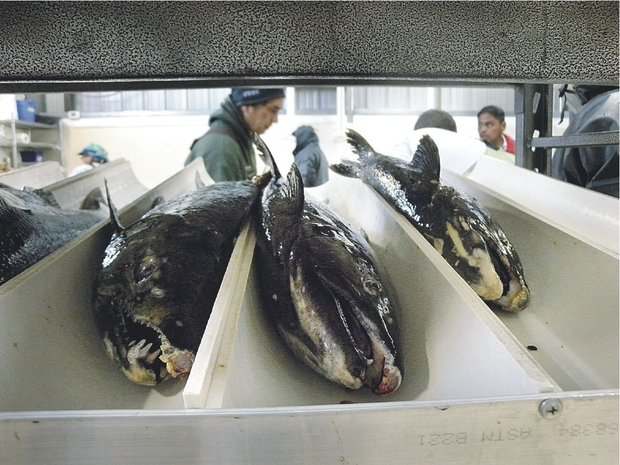forum
library
tutorial
contact

Fall Chinook, Coho Fishing Open for All
in Most Areas of Columbia River
by Staff
Columbia Basin Bulletin, August 12, 2006
|
the film forum library tutorial contact |

|
Fall Chinook, Coho Fishing Open for All
by Staff
|
 Recreational angling for fall chinook and coho salmon opened in most areas of the Columbia River last week, including the popular Buoy 10 fishery, as well as in Columbia tributaries, and in some coastal streams.
Recreational angling for fall chinook and coho salmon opened in most areas of the Columbia River last week, including the popular Buoy 10 fishery, as well as in Columbia tributaries, and in some coastal streams.
(See CBB, August 5, 2016, "Higher Than Average Fall Chinook Run On The Way; Coho, Steelhead To Be Lower Than 10-Year Average")
In addition, non-tribal commercial gillnetters fished three times this week -- Sunday, Tuesday and Thursday evenings -- from Warrior Rock near St. Helens, Ore. to Bonneville Dam. And, a two-state Columbia River Compact decision this week will allow Tribal fishers to begin gillnetting upstream of the dam beginning August 22.
The 2016 forecast for fall chinook entering the Columbia River is 960,200 fish, which is 74 percent of last year's actual return, but 136 percent of the 2006-2015 10-year average of 705,600 fish.
Passage of the upriver fall chinook through Bonneville Dam is expected to hit nearly 628,000 adults. As of Wednesday, 7,934 adults and 840 jack fall chinook had passed Bonneville Dam, which is above the 10-year average of 5,390 fall adults for that date, but the number of jacks is lower than the average of 1,103 fish. Passage is typically 50 percent complete by September 8.
Last year 10,753 fall chinook and 922 jacks had passed on this date.
See www.fpc.org/web/apps/adultsalmon/R_yeartodatecomparisontable_results.php for dam counts, including last year's comparison and the 10-year average.
According to Compact Fall Fact Sheet No. 2, approximately 29 percent of the fall chinook at Bonneville are adipose fin-clipped. "This is a sign that the run contains a significant number of wild fish," the Fact Sheet said.
Just 8 coho salmon and 3 coho jacks had passed the dam as of Wednesday, far below the 10-year average of 37 adults and 8 jacks. Last year at this time 36 adults and 14 jacks had passed by this date.
Some 322,600 coho salmon are expected to enter the Columbia River, which is 73 percent of the 10-year average of 441,400 fish. It includes 132,900 early stock and 189,700 late stock. Passage of coho over Bonneville Dam is expected to total 84,300, which is 76 percent of the total ocean abundance of Columbia River coho destined for areas upriver of the dam.
The stock that may limit the amount of fishing allowed this year is steelhead. Some 256,200 upriver summer steelhead are expected to pass Bonneville Dam April through October. That includes 96,500 wild steelhead. Fish that pass July through October are categorized as either group A (less than 78 centimeters -- 30.7 inches) or group B (greater than 78 cm). Group A generally pass the dam during July and move up into Columbia and Snake river tributaries, while Group B pass the dam around the end of August and primarily return to Snake River tributaries.
The Group A forecast is 82 percent of its 10-year average, while the Group B forecast is 53 percent of the 10-year average.
Counts of steelhead at Bonneville Dam through Wednesday are 78,591 hatchery steelhead and 28,863 wild steelhead. Last year 118,902 hatchery steelhead and 55,455 wild steelhead had passed the dam by this date. The 10-year average for hatchery steelhead is 153,338 and 64,443 for wild steelhead. Passage at Bonneville Dam (July-October) is typically 50 percent complete by August 11.
Last week the Compact set non-Tribal gillnetting periods, including periods that began this week. The three periods this week were: 9 pm Sunday, August 7 to 6 am Monday August 8; 9 pm Tuesday, August 9 to 6 am Wednesday, August 10; and 9 pm Thursday, August 11 to 6 am Friday, August 12.
Next week's three periods are: 9 pm Sunday, August 14 to 6 am Monday, August 15; 9 pm Tuesday, August 16 to 6 am Wednesday, August 17; and 9 pm Thursday, August 18 to 6 am Friday, August 19.
The final three periods set by the Compact are: 9 pm Sunday, August 21 to 6 am Monday, August 22; 9 pm Tuesday, August 23 to 6 am Wednesday, August 24; and 9 pm Thursday, August 25 to 6 am Friday, August 26 (see July 27 Compact Action Notice).
This week the Compact set four weekly Tribal gillnetting dates, all 4.5 days each week (see August 9 Compact Action Notice). They are:
With an expected effort by the Tribal gillnetters of 440 to 670 nets each week, harvest is forecasted to be 190,300 fall chinook, including 1,000 from platform hook and line fishing,129,400 upriver bright chinook, and 14,030 steelhead, including 2,220 B-run steelhead.
After the September 16 ending date, the Tribes expect to have 8 percent of their chinook harvest allotment remaining and 11 percent of their B-run steelhead allotment remaining.
learn more on topics covered in the film
see the video
read the script
learn the songs
discussion forum
